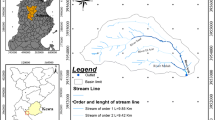Abstract
A Geographic Information System (GIS) has been integrated with the USLE (Universal Soil Loss Equation) model in identification of rainfall-based erosion and the transport of nonpoint source pollution loads to the Gediz River, which discharges into the Aegean Sea along the western coast of Turkey. The purpose of the study is to identify the gross erosion, sediment loads, and organic N loads within a small region of the Gediz River basin. Similar studies are available in literature, ranging from those that use a simple model such as USLE to others of a more sophisticated nature. The study presented here reflects the difficulties in applying the methodology when the required data on soil properties, land use and vegetation are deficient in both quantity and quality, as the case is with most developing countries.
Similar content being viewed by others
References
De Jong, S. M.: 1994, ‘Applications of reflective remote sensing for land degradation studies in a Mediterranean environment', Neth. Geograph. Stud. 177, 237.
De Roo, A. P. J.: 1996, ‘Soil Erosion Assessment using G.I.S.', in V. P. Singh and M. Fiorentino (eds), Geographical Information Systems in Hydrology, Kluwer Academic Publishers, Water Science and Technology Library, Dordrecht, Vol. 26, pp. 339–356.
Dryer, D. and Frhlich J.: 1994, ‘A GIS-based Soil Erosion Model for Two Investigation Areas in the High Rhine Valley and the Swiss Jura Plateau (NW Switzerland)', in J. J. Harts, H. F. L. Ottens, H. J. Scholten and J. van Arragon (eds), Proceedings of the Fifth European Conference on Geographical Information Systems, Paris, EGIS Foundation, Utrecht/Amsterdam, pp. 1032–1041.
Fistikoglu, O.: 1996, ‘The Use of Geographic Information Systems (GIS) in Water Resources Research and Management', M.Sc. Thesis in Civil Engineering (Advisor: Prof. Dr. N. Harman-cioglu) Dokuz Eylul University, Graduate School of Natural and Applied Sciences.
Fraser, R. H., Barten, P. K. and Tomlin, C. D.: 1996, ‘SEDMOD: A GIS-based Method for Estimating Distributed Sediment Delivery Ratios', in C. A. Hallam, K. J. Lanfear, J. M. Salisbury and W. A. Battaglin (eds), GIS and Water Resources, AWRA Technical Publication Series, TPS–96–3, pp. 137–146.
Foster, G. R.: 1982, ‘Modeling the Erosion Process', in Haan et al.(eds), Hydrologic Modeling of Small Watersheds, ASAE Monograph No. 5, pp. 297–380.
Haan, C. T. and Storm, D. E.: 1996, ‘Nonpoint Source Pollution Modeling (with GIS)', in V. P. Singh and M. Fiorentino (eds), Geographical Information Systems in Hydrology, Kluwer Academic Publishers, Water Science and Technology Library, Dordrecht, Vol. 26, pp. 323–338.
Hession, C. W., Flagg, J. M., Wilson, S. D., Biddix, R. W. and Shanholtz, V. O.: 1992, ‘Targeting Virginia's Nonpoint Source Programs', ASAE Paper, No. 92–2092, ASAE, St. Joseph, MI.
Heidtke, T. M. and Auer, M. T.: 1993, ‘Application of a GIS-based nonpoint source nutrient load-ingmodel for assessment of land development scenarios and water quality in Owasco Lake, New York', Water Sci. Technol. 28(3–5), 595–604.
Hession, C. W. and Shanholtz, V. O.: 1988, ‘Geographic information system for targeting nonpoint source agricultural pollution', J. Soil Water Conserv. 43(3), 264–266.
Lørup, J. K. and Styczen, M.: 1996, ‘Soil Erosion Modeling', in M. B. Abbott and J. C. Refsgaard (eds), Distributed Hydrological Modeling, Kluwer Academic Publishers, Water Science and Technology Library, Dordrecht, Vol. 22, pp. 93–120.
Mallants, D. and Feyen, J.: 1989, ‘Hydrological systems modelling of the rainfall-runoff conversion using a Digital Terrain Model', Landscape 4, 277–290.
McElroy, A. D., Chiu, S. Y. and Nebgen, J. G.: 1976, Loading Functions for Assessment of Water Pollution from Nonpoint Sources, Environmental Protection Technical Service, EPA 600/2–76–151.
Mitchell, J. K., Engel, B. A., Srinivasan, R. and Wang, S. S. Y.: 1993, Validation of AGNPS for Small Watersheds using an Integrated AGNPS/GIS System, Geographic Information Systems and Water resources, March 1993, pp. 89–100.
Moore, I. D.: 1990, ‘Geographic Information Systems for Land and Water Management', Proceedings of Soil and Water Conservation Association Australia Annual Conference, 5–6 November 1990, Canberra.
Novotny, V. and Olem, H.: 1994, Water Quality Presentation, Identification, and Management of Diffuse Pollution, Van Nostrand Reinhold, New York, U.S.A.
Robinson, K. J. and Ragan, R. M.: 1994, ‘Geographic information system based nonpoint source pollution modeling', Water Resour. Bull. 29(6), pp. 1003–1008.
Roehl, J. W.: 1992, ‘Sediment source areas, delivery ratios and influencing morphological factors', Internat. Assoc. Hydrol. Sci. 59, 202–213.
Tim, U. S., Mostaghimi, S. and Shanholtz, V. O.: 1992, ‘Identification of critical nonpoint pollution source areas using GIS and water quality modeling', AWRA, Water Resour. Bull. 28(5), 877–887.
Wischeimer, W. H. and Smith, D. D.: 1965, Predicting Rainfall Erosion Losses from Cropland East of Rocky Mountains, U.S. Department of Agriculture, Agricultural Handbook, No. 282, Washington, D.C.
Yoon, J.: 1996, ‘Watershed-scale Nonpoint Source Pollution Modeling and Decision Support System based on a Model-GIS-RDBMS Linkage’, in C. A. Hallam, K. J. Lanfear, J. M. Salisbury and W. A. Battaglin (eds), GIS and Water Resources, AWRA Technical Publication Series, TPS–96–3, pp. 99–108.
Author information
Authors and Affiliations
Corresponding author
Rights and permissions
About this article
Cite this article
Fistikoglu, O., Harmancioglu, N.B. Integration of GIS with USLE in Assessment of Soil Erosion. Water Resources Management 16, 447–467 (2002). https://doi.org/10.1023/A:1022282125760
Issue Date:
DOI: https://doi.org/10.1023/A:1022282125760




